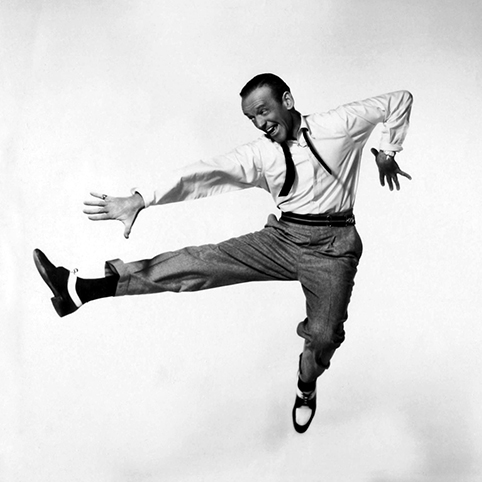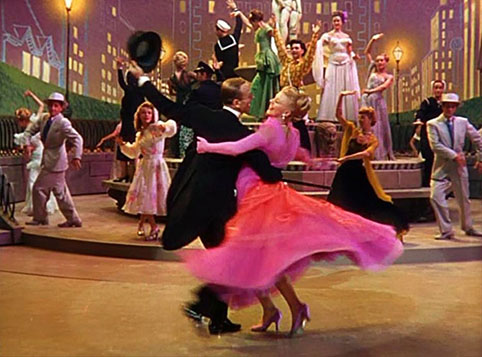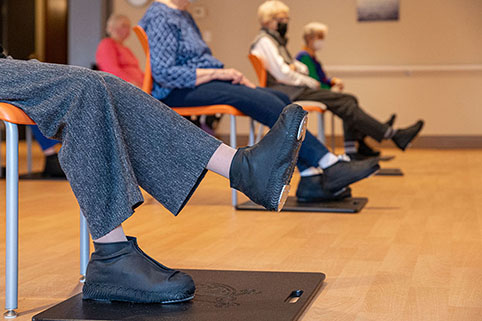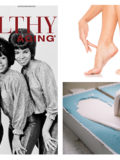
Fred Astaire in Daddy Long Legs, 1955. Photo: Wikimedia Commons Public Domain
By Melissa Renner
Did you know that dancing is one of the best activities for our brains and bodies?
From social dancing like line, square, or ballroom to freestyle dancing (Some of us used to call it disco), dancing not only gets the body moving but fires up our brains.
The rapid-fire of neurons deciding which move to do next is incredibly stimulating for our brains. Ergo, there is the constant and simultaneous cognitive and physical stimulus for the mind and body.
A study published by the New England Journal of Medicine found that dancing regularly reduced the risk of dementia by 76%, which was twice as much as reading.
And, let’s not forget about the mood-lifting benefits and good old-fashioned fun that dancing provides.
Returning to Dance
You might think your dancing days are in the past. However, it’s never too late to bring dance back into your life. And why not make it tap dancing!

Fred Astaire and Ginger Rogers in the Barkleys of Broadway. Photo: Wikimedia commons Public Domain
Tap Dancing
Perhaps, you tried tap dancing when you were little. Or, maybe, you just marveled at the world-class tap dancer greats on the silver screen.
Remember Fred Astaire and Ginger Rogers in Swing Time? Or, how about The Nicholas Brothers in the unforgettable Jumpin’ Jive” (with Cab Calloway and his orchestra) featured in the 1943 movie Stormy Weather?
Ann Miller enthralled audiences with her tap dance routine on a coffee table in the 1953 movie, Kiss Me Kate. Who could forget Gene Kelly tapping his way along the rainy street in Singing in the Rain or the “Audition” in the long-running 42nd Street?
They were amazing and exhilarating.
The magic of tap dancing comes from the rhythmic sound of the metal “taps” attached to the toe and heel of the shoe. The percussive, clickity-clack sound made along with the dancing movements provide the dancer with a unique form of self-expression.
Five top health benefits of tap dancing:
Cardiovascular health
Tap dancing is a beautiful form of cardiovascular exercise to improve your cardiovascular health. With experts recommending at least three days of cardiovascular exercise a week, tap dancing is a fun and unique way to meet that quota. If you need a little direction, check out this video for a beginner tap dancing combination or this video for a seated tap dance number if you need to stay seated.
Cognitive health
Tap dancing is a positive way that can help those with Alzheimer’s Disease or dementia while increasing cognitive acuity. Tap dancing can enhance cognitive abilities similar to how physical exercise can overall keep the body fit.
As you learn and practice tap dancing, or, if you are already an avid tap dancer, add tap combinations to your repertoire, you are developing muscle and mental memory. Anytime you can improve brain and body health at the same time, it is a win-win!
Strength
Watch anyone tap dance, whether it is standing or adapted tap dance from a chair, and it is no surprise that tap dancing is an excellent way to build strength in the muscles and joints of your lower extremities. All of those ‘shuffle ball changes’ strengthen the feet, ankles, and legs. Tone your thighs and burn calories with a form of dance with as much history as it has style.
Balance
Balance training is imperative for health as we grow older, and tap dancing is an excellent exercise to help build balance. As you tap dance, your core is engaged, which is essential since balance begins with your core, and you are strengthening the proprioceptors that also help improve balance. The core is more than just our abdominal muscles. It includes our lower back and strong hips, which are essential for solid balance. Individuals with weak core muscles are more prone to falls, decreased mobility in the spine, slower reflexes, and lower back injuries.
Good balance also supports mental clarity and can ease anxiety. Researchers concluded that people who took part in balance exercise programs had more significant cognitive gains than those who did not.

Tap shoe specifically designed for those who need physical assistance. Photo: Active For Life Fitness
Everyone Can Do It
Tap dance can be customized to everyone, no matter what age or skill level.
For example, if tap dancing puts too much stress on your knees if you are mobile or even in a wheelchair, seated tap dancing is a perfect option to engage in this fun activity while still receiving the health benefits.
There are many options now for adapted dance and fitness. For example, if you require an orthopedic shoe or prefer the comfort of your favorite pair of sneakers over a narrow tap shoe, I created a tap shoe cover for this purpose.
The tap shoe cover allows you to keep your shoes on while still participating in tap dancing.
The tap shoe cover made of silicon rubber, with the help of a zipper, fits over a regular or orthopedic shoe. Two metal tap disks on the bottom allow dancers to tap dance while seated.
I also created a patent-pending hand tap for paralyzed people or unable to use their feet to tap dance. The hand tap is a mitt without a thumb hole that slips over a hand and allows an individual to participate in the seated dance classes.
Considering there are so many possibilities, tap-dancing truly is an excellent form of exercise for young children to 100 years olds. Check out this video of a group of women ages 50 – 95 in a seated tap dance class for inspiration.
Remember that with so many different forms of exercise, choose one that you enjoy. Life is too short not to dance your way through it.













